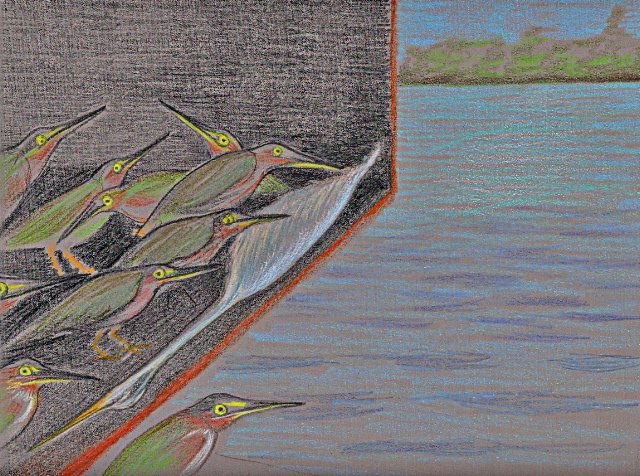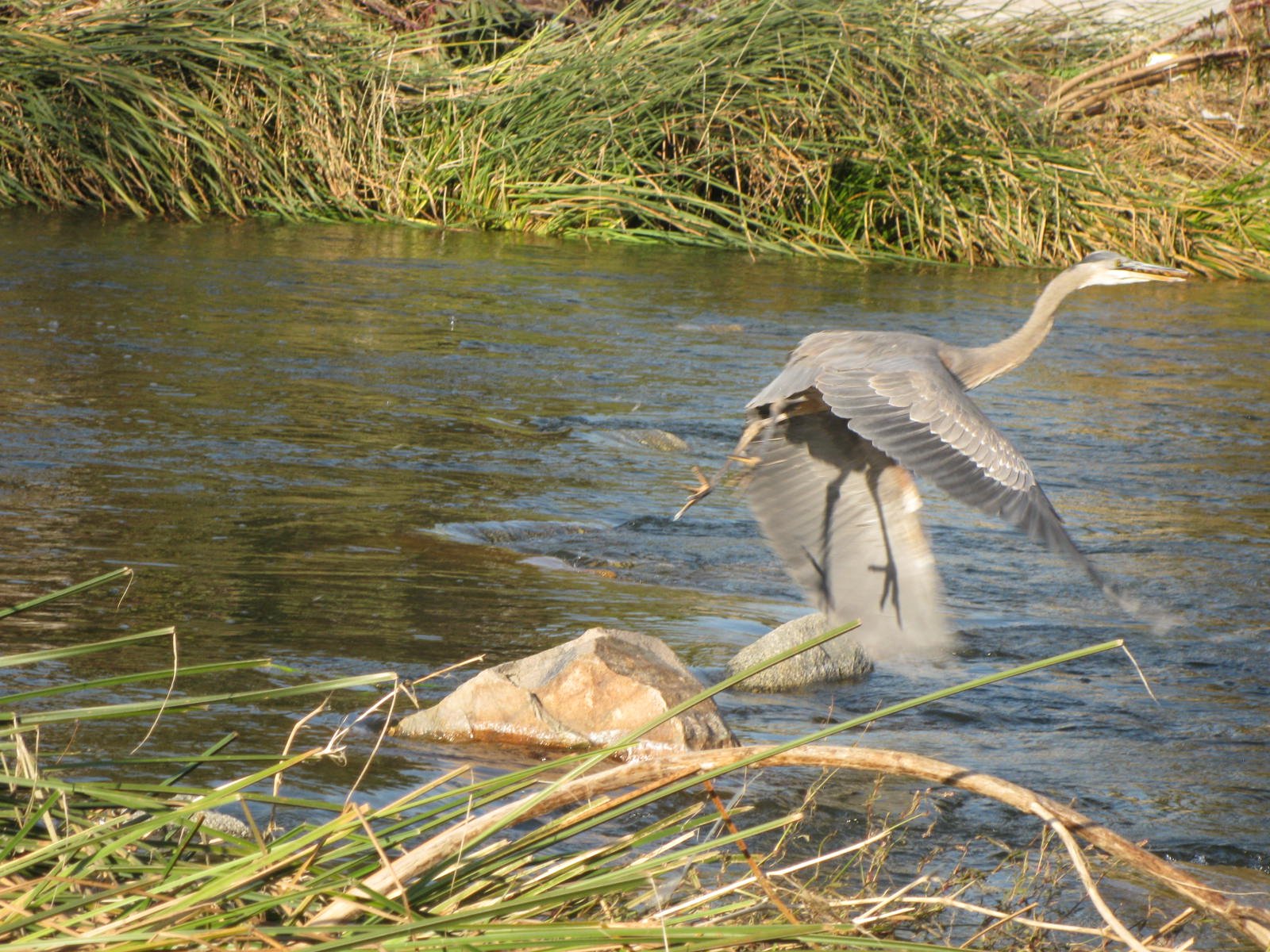Woke Into Heron
 (heron dream drawing by Beth Thielen, c. 2012)Matilija poppies are blooming along the L.A. River… bright yellow and white, like fried eggs. I’m grateful to have an hour to ride my bike in what’s left of the morning overcast, to let my thoughts whir with my wheels while I inhale the unique salvia-sewage tang of the river. I think about Terry Tempest Williams, naturalist and poet, whom I had the honor of interviewing recently at ALOUD.The title of her new book, WHEN WOMEN WERE BIRDS, came to Terry in a dream.There’s a great blue heron on my left, and another. A pair of cormorants, a crow chasing an avocet, stalking egrets, a swallow alighting on a fence railing. The Seventh Day Adventists are strolling adjacent Frogtown, briefcases in hand. A father in a white shirt and tie speaks tenderly to his son. Last night on my way home from downtown, I peered into the open door of the Pentecostal church on Glendale Blvd, where white-scarved women were clapping tambourines and praising the Lord to the beat of an bass guitar. Birds are singers of life, not of death, as naturalist Loren Eisley reminds us, as Terry reminds us "that the world is meant to be celebrated.Terry Tempest Williams inherited her mother’s journals after her mother died. Or rather, her mother bequeathed those journals to her, after extracting a promise that she wouldn’t open them until after she was gone. Terry's mother left too soon, even younger than my mother, who left too soon. Cancer claimed both our beautiful mothers.Terry opened the first journal on the shelf and to her astonishment, found that it was blank. As was the next and the next and the next. What was her mother’s intention in leaving her daughter these empty pages? Terry’s stunning and unclassifiable book is an inquiry into the power of absence. It is the creation story of her own sensibility as an artist, naturalist, activist. It is a dialectic between silence and voice. (The subtitle is: Fifty-Four Variations on Voice). It is about censure and erasure and about daring to speak up.Birds wing through many pages of the book, through Terry’s family life. Peterson’s Field Guide to Western Birds was the first book Terry took to bed at night. It was her grandmother Mimi who helped her learn the songs of birds. Redtail hawks circled high above my first wedding on the Oregon coast, on a cliff above Cape Foulweather in 1971. Some of the guests wondered at the lack of an officiant, but my Russian grandmother Rebecca, wrapped in a pink blanket, nodded sagely and said, “I understand, the ocean is marrying you.”Blue heron stalks the shallows of the river, waiting, watching. Was the heron once a woman? Could I join the mockingbird outside my window in song? Might I someday wake into heron like the girl in this Swampy Cree poem?Woke Into HeronShe was tall, you could see herin the distance before anyone.Once, in late summer,she stood so long at the edgeof the swampwe thought she was readyto leave with the herons.You could see her standingVery still.The day the herons leftshe stayed. The next day she woke as a girlall right, but she began being a HERON!She took long steps, slowly, as if she waswalking in water, hunting in water.This is true, and she did thismaking heron noises.AND had thin stickstied out from her feetto make heron tracks.This went awaythe next morning. Everyonewas happy she would no longergo sleep in the water reeds.This was the first time we saw someonedo this, so we named hernot to forget it.(from, “Woke Into Heron” published in The Wishing Bone Cycle: Narrative Poems from the Swampy Cree Indians, gathered and translated by Howard A. Norman, Stonehill Publishing, 1976)Heron Dream Drawing by Beth Thielen, c.2012
(heron dream drawing by Beth Thielen, c. 2012)Matilija poppies are blooming along the L.A. River… bright yellow and white, like fried eggs. I’m grateful to have an hour to ride my bike in what’s left of the morning overcast, to let my thoughts whir with my wheels while I inhale the unique salvia-sewage tang of the river. I think about Terry Tempest Williams, naturalist and poet, whom I had the honor of interviewing recently at ALOUD.The title of her new book, WHEN WOMEN WERE BIRDS, came to Terry in a dream.There’s a great blue heron on my left, and another. A pair of cormorants, a crow chasing an avocet, stalking egrets, a swallow alighting on a fence railing. The Seventh Day Adventists are strolling adjacent Frogtown, briefcases in hand. A father in a white shirt and tie speaks tenderly to his son. Last night on my way home from downtown, I peered into the open door of the Pentecostal church on Glendale Blvd, where white-scarved women were clapping tambourines and praising the Lord to the beat of an bass guitar. Birds are singers of life, not of death, as naturalist Loren Eisley reminds us, as Terry reminds us "that the world is meant to be celebrated.Terry Tempest Williams inherited her mother’s journals after her mother died. Or rather, her mother bequeathed those journals to her, after extracting a promise that she wouldn’t open them until after she was gone. Terry's mother left too soon, even younger than my mother, who left too soon. Cancer claimed both our beautiful mothers.Terry opened the first journal on the shelf and to her astonishment, found that it was blank. As was the next and the next and the next. What was her mother’s intention in leaving her daughter these empty pages? Terry’s stunning and unclassifiable book is an inquiry into the power of absence. It is the creation story of her own sensibility as an artist, naturalist, activist. It is a dialectic between silence and voice. (The subtitle is: Fifty-Four Variations on Voice). It is about censure and erasure and about daring to speak up.Birds wing through many pages of the book, through Terry’s family life. Peterson’s Field Guide to Western Birds was the first book Terry took to bed at night. It was her grandmother Mimi who helped her learn the songs of birds. Redtail hawks circled high above my first wedding on the Oregon coast, on a cliff above Cape Foulweather in 1971. Some of the guests wondered at the lack of an officiant, but my Russian grandmother Rebecca, wrapped in a pink blanket, nodded sagely and said, “I understand, the ocean is marrying you.”Blue heron stalks the shallows of the river, waiting, watching. Was the heron once a woman? Could I join the mockingbird outside my window in song? Might I someday wake into heron like the girl in this Swampy Cree poem?Woke Into HeronShe was tall, you could see herin the distance before anyone.Once, in late summer,she stood so long at the edgeof the swampwe thought she was readyto leave with the herons.You could see her standingVery still.The day the herons leftshe stayed. The next day she woke as a girlall right, but she began being a HERON!She took long steps, slowly, as if she waswalking in water, hunting in water.This is true, and she did thismaking heron noises.AND had thin stickstied out from her feetto make heron tracks.This went awaythe next morning. Everyonewas happy she would no longergo sleep in the water reeds.This was the first time we saw someonedo this, so we named hernot to forget it.(from, “Woke Into Heron” published in The Wishing Bone Cycle: Narrative Poems from the Swampy Cree Indians, gathered and translated by Howard A. Norman, Stonehill Publishing, 1976)Heron Dream Drawing by Beth Thielen, c.2012